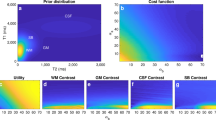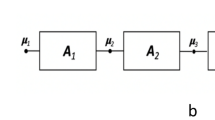Abstract
A rigorous reformulation of the magnetic resonance (MR) image formulation model (IFM) can use the integrally cumulative nature of MRI phase shifts for encoding and of time-of-flight travel corrections for magnitude. This approach characterizes each independent gradient element by its cumulant waveforms,K N (t), instead of by particular time expansion in gradient moments. The lowest-order cumulant gradient that gives a simple monopolar waveform governs all resulting phase-encoding properties. Each gradient element specifically encodes one and only one motion-order variable. Phase sensitizations to “higher order” do not exist; they are mathematical psuedophasings. Magnetization isochromats may have arbitrarily complicated velocity history,V(t), appearing in both time-of-flight and motion phase-shift formulas. The subject's intravoxel motion subdistributions each automatically reference the correct mean time of encoding action and its encoding duration. This formulation yields very simple and generalizable IFM expressions for MRI acquired data, with no theoretical confusion regarding higher-order phase shifts and nonphased time-of-flight effects.
Similar content being viewed by others
References
Moran PR (1991) Experiments for two MR imaging theories of motion phase sensitivity.Radiology 180 115–119.
Frank LR, Adrian PC, Buxton RB (1992) Elimination of oblique flow artrifacts in MRI.MRM 25 299–307.
van Tyen R, Saloner D, Jou LD, Berger S (1993) MR imaging of flow through Tortous vessels: a numerical simulation.MRM 31 184–195.
Urchuk SN, Plewes DB (1992) Mechanisms of flow-induced signal loss in MR angiography.J Magn Reson Imaging 2 453–462.
Simonetti OP, Wendt RE III, Duerk JL (1991) Significance of the point of expansion in interpretation of gradient moments and motion sensitivity.J Magn Reson Imaging 1 569–578.
Author information
Authors and Affiliations
Rights and permissions
About this article
Cite this article
Moran, P.R. A new MRI formulation for flow and motion applications. MAGMA 2, 185–189 (1994). https://doi.org/10.1007/BF01705239
Issue Date:
DOI: https://doi.org/10.1007/BF01705239




